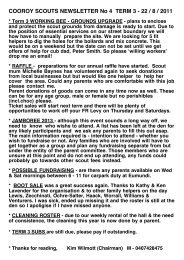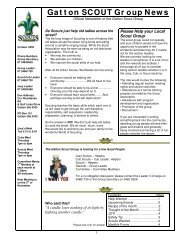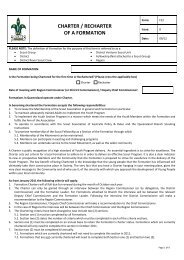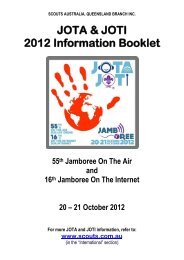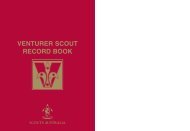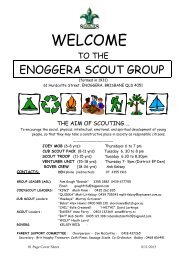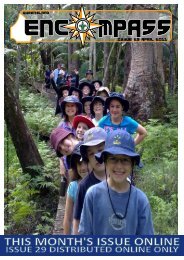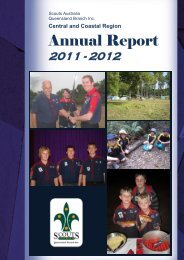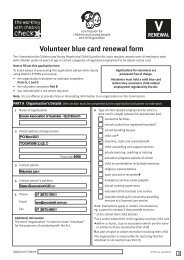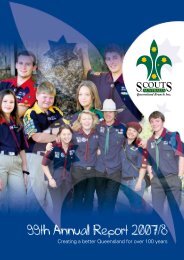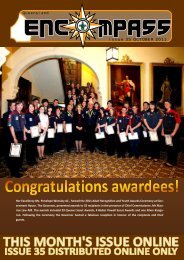Encompass Issue 52 â May 2013 - Kawana Scouts
Encompass Issue 52 â May 2013 - Kawana Scouts
Encompass Issue 52 â May 2013 - Kawana Scouts
You also want an ePaper? Increase the reach of your titles
YUMPU automatically turns print PDFs into web optimized ePapers that Google loves.
BATTLESHIPS AND MINEFIELDSEquipment—BlindfoldsInstrucons—All but one member of one Six are blindfolded andstand in a line (the Baleship), one behind the other, with hands onthe hips of the Cub in front of them. The remaining Six member isthe Captain of the Baleship. All other Cubs sit (without blindfolds)around the floor, or some poron thereof (the Minefield), of thehall, far enough apart so that the Baleship can easily pass betweenany two, but in a way that there is no clear path from one end ofthe minefield to the other. The Captain must guide his Baleshipthrough the Minefield giving only instrucons comprising aCompass Direcon and a Number of Paces. The 'Mines' of course,must remain very quiet throughout, lest they reveal their posionto the Baleship. Set a me limit for the passage.BALLOON BOUNCEEquipment—One inflated balloon foreach Six (or team)Instrucons—Members of each Sixform a close circle around their Sixer.The Sixer holds the balloon. At a givensignal, each Sixer taps his or herballoon into the air. The object of thegame is to keep the Six's balloon inthe air by tapping it upwar. No Cub may touch the balloon twice ina row; there must always be an intervening tap from another Cub. Ifa Six's balloon touches a Cub from another Six, the Cub touchedmust drop out. Cubs from one Six can interfere with Cubs fromanother Six as long as they don't touch the other's balloon. As soonas a balloon touches the floor, all members of that Six must dropout. The last Six le is the winner.CATCH IT—HEAD ITEquipment—BallInstrucons—The Pack stands in a circlewith a player/Leader in the middle. Theperson in the middle throws the ball toanyone in the circle, shoung "Catch It!" or"Head It!". If the player in the circle catchesthe ball when the order was to head it, orvice versa, they are out.18NEED INSPIRATION?Have a look at theNew Acvies box on thehome page of Eurekit fornewly published acvies.CUB SCOUT BOOMERANG (SILVER) TEST 10 –DISCOVERYMake a simple colour wheeland show when rotated howthe colours blend to form awhite colourResources• Cardboard discs (8cm dia)• (Strong) thread or finestring• Paper colour wheeltemplates• Coloured pencils, crayonsor felt pens• Scissors or circular cuer• Paper glueInstrucons1. Colour in a colour wheel template.Two different templates are provided. One has 14 divisions, to becoloured in using the seven basic colours of the rainbow (Red,Orange, Yellow, Green, Blue, Indigo, Violet). Colour two wheeldivisions (either adjacent or opposite segments) in each colour;The second template is divided into 6 segments, and is also dividedradially with 4 concentric rings. This template can be used toobserve the effects of mixing different combinaons of colours (e.g.Red + Blue, Red + Yellow, Blue + Yellow);2. Cut out the coloured wheel, using either scissors or a circularcuer.3. Using a small amount of paper glue, aach the coloured wheel tothe cardboard disc (just a dab in the centre of the wheel is all that isrequired—it can then be easily changed);4. Using a pin or the point of a compass, punch two holes, to matchthe two outer holes in the cardboard disc, in the coloured wheel;5. Thread a piece of strong coon or fine string (~1 metre) throughthe two outer holes (not the centre hole) in the colour wheel ande the two ends of the string together;6. With fingers through the looped ends of the string, on either sideof the disc (colour wheel), wind (or have someone wind for you) thedisc around several mes.7. Pull the string gently with both hands, drawing away from thecolour wheel—the wheel should begin to turn. Now, here’s thetrick… Just as the thread becomes fully unwound, and with thecolour wheel spinning, release the tension on the string justenough that the colour wheel can connue to turn and wind thestring in the opposite direcon.Just as the colour wheel stops spinning, pull gently again on thestring, as before—the wheel should then start spinning in theopposite direcon (faster than before).Again, just as the thread becomes fully unwound, release thetension on the string, and allow the colour wheel to keep spinningand winding up the thread again. By gently pulling and thenreleasing the tension on the string, as described above, you shouldbe able to make the disk spin to and fro. Watch what happens tothe colours on the colour wheel as it spins.



